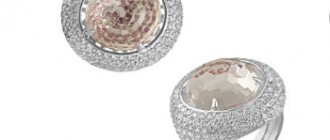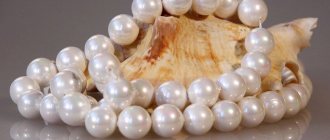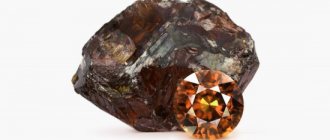Unique gemstone changes color depending on the light
Alexandrite was discovered relatively recently, only about two centuries ago, but already has a rich history and great popularity. Alexandrite jewelry looks great in both gold and silver. As a fossil, it is rarely found in nature, making the crystal very expensive and unique.
History of the stone
All precious stones, including alexandrite, have their own history. The past bears its imprint and forms in the consciousness of humanity one or another meaning of the crystal associated with various events. Ural alexandrite was first discovered and described in 1832. Archaeologist Lev Petrovsky studied the characteristics and properties of this mineral. When the future Russian monarch Alexander II turned 16, this unique stone was presented to him as a gift. And from that moment on, the gem began to be called alexandrite in honor of the Russian Tsar.
The emperor really liked the stone and ordered the jeweler to make a ring. Subsequently, at all important events, he always appeared with this decoration. Rumor ascribes that it was the ring with alexandrite that repeatedly saved the king’s life. He survived several assassination attempts and remained alive. But one unfortunate day he did not put on his talisman and died. From that moment on, faith in the magical properties of alexandrite only strengthened. The crystal was very popular among the highest nobility at court. Due to the high cost of the gem, only rich people could afford such jewelry, so the crystal received a second name - the imperial (royal) stone.
During the First World War, the magical properties of the stone began to be negative. Many people died, including from noble families who had talismans and jewelry made of alexandrite. The wives, not waiting for their husbands, lived alone for centuries. The mineral began to be called “widow’s stone,” and interest in it began to fade. But time passed, troubles and grief subsided. The gem once again began to attract attention with its beauty and uniqueness.
Gold pendant with alexandrite and cubic zirconia (go to the SUNLIGHT catalogue)
Colors and varieties
Alexandrite raw
Alexandrites are classified according to their color:
- Colored.
- Colorless.
- Digitizers are translucent samples that have a cat's eye effect or asterism.
According to the place of extraction, imperial stones are divided into:
- Ural ones are the most beautiful and expensive. In natural light, Ural alexandrites have a bright and multifaceted blue-green color. Under artificial light, the stones turn raspberry-purple. The color reverse of Russian gems is recognized as the deepest.
- Indian or from Sri Lanka . The transitions of their colors are smoother and less deep. During the day, the samples are greenish-blue, in the evening they are blue-violet with a slight reddish tint.
- African and Brazilian . In daylight, such alexandrites have a brown-green color; under lamps they reveal a reddish tint.
Ural stone alexandrite
Natural description of the stone
Natural crystal is very rare in nature. In Russia it is mined in the Ural Mountains. It is interesting that during excavations, alexandrite is almost never adjacent to emerald. Millions of years ago, the formation of these two crystals required the same basic minerals: beryllium and chromium. If silicon also reacts, the result is an emerald. Alexandrite does not contain silicon. At first, these crystals were often confused.
There are quite large deposits on the island of Sri Lanka. Suppliers of these precious stones to the world market are: India, Brazil, Burma, Madagascar and some other small countries in Asia and Africa. But Ural alexandrites are considered the most valuable, pure and expensive.
Alexandrite is a variety of chrysoberyl. Its unique property of changing color depending on the time of day or angle is striking. In daylight it has a bluish-green tint; in artificial light it turns red and even purple. From a different perspective, the gem can take on a dark blue, purple tone, and sometimes shines yellow or brown. This chameleon effect is of great value in jewelry.
Since natural alexandrite is rare and very expensive, scientists have found a way to create the mineral artificially. One option that is relatively cheap is corundum with an admixture of vanadium. The second imitation is more expensive and more complex - artificial cultivation. It is interesting that during the Soviet era, not a single natural crystal was sold in the country; synthetic alexandrite replaced it in jewelry. In appearance: beauty, transparency, brilliance and color saturation, artificial alexandrite is in no way inferior to natural one.
MASKOM gold ring with alexandrite and cubic zirconia (go to the SUNLIGHT catalogue)
Physical and chemical properties
Alexandrite
Alexandrite belongs to the chrysoberyl group. The special structure of the crystal lattice and the location of trivalent chromium ions in it as an impurity determine the presence of a unique optical effect in the mineral.
Under artificial and natural lighting, light rays are reflected differently as they pass through the crystal. This is why it appears blue-green during the day and purple-red in the evening - an alexandrite color reverse.
The mineral melts at a temperature of 1800 degrees, is resistant to acids, except hydrofluoric and boric acid, and is unstable to alkalis.
| Formula | Al2BeO4 |
| Color | Changes from emerald green to purple red |
| Probable impurities | Chrome, titanium, iron, vanadium |
| Shine | Glass |
| Hardness | 8,5 |
| Transparency | Transparent or translucent |
| Strength | Lasting |
| Kink | Conchoidal |
| Cleavage | Imperfect |
| Density | 3.5-3.84 g/cm3 |
| singonia | Rhombic |
| Refractive index | 1,744-1,758 |
Alexandrite and astrology
Each zodiac sign has its own talisman stone. But in this case, astrologers of different schools disagree on who is suitable for alexandrite. Due to its ability to change its color and duplicity, the crystal can protect Gemini. The patronage of Mercury over the stone also corresponds to this zodiac sign.
Russian astrologers, based on the history of the mineral, believe that the imperial (royal) stone is most suitable for Leos. It is a symbol of monarchy, power and authority. The characteristics of Lviv precisely suggest these qualities.
Jewelry with alexandrite can be worn by Aquarius, Libra, Aries, Pisces, Scorpio. The mineral will bring luck and glory to these zodiac signs. But first you will need to pass some tests that fate will send. If a person gets out of trouble with dignity, then in the future the stone will serve and protect him. But if he shows weakness and goes with the flow, then the crystal is not a helper. According to the horoscope, it is believed that alexandrite is suitable for those who initially have a strong will and desire to win. The crystal will enhance your energy and help you achieve new heights.
But Taurus, Virgo and Cancer should be careful. Alexandrite and these zodiac signs are incompatible. The gem will have a negative impact in all endeavors. Well, for those who, despite the warning, still really like alexandrite in jewelry, it is worth remembering that sometimes you can wear it, but you should not take it with you to important events.
Gold bracelet with alexandrite (go to the SUNLIGHT catalog)
Who suits the name
The name of the stone suggests that it is the patron saint of Alexander and Alexandra. This is true.
Sashas of any gender can count on maximum and comprehensive support from the stone. As long as alexandrite is nearby, its namesakes will be invulnerable both physically and mentally. In addition, they will receive everything they have long dreamed of.
Alexandrite is also happy to help change the lives of Ivans and Yuli, Eva and Evgeniy, Nikolai and Tatiana, Irin and Dmitry for the better.
The magical influence of the stone
The magical properties of the alexandrite stone cannot be overestimated. This is truly a unique gem. He has incredible power in attracting success, wealth, and power. The owner of the stone, if they become friends, will reach unprecedented heights in their career and personal life. But do not forget that this mineral does not respect weak, weak-willed people. Therefore, for him to become a talisman and assistant, you need to be active yourself.
Alexandrite has strong predictive properties. If it has acquired a yellow or brown tint, then you should be more careful - this is how the stone warns the owner of danger.
The legend that alexandrite is a “widow’s stone” is a thing of the past and overgrown with grass, but many mystics believe that the gem brings loneliness. To prevent this from happening, alexandrite should be worn in pairs. For example, you can purchase earrings or a pendant to go with the ring. Then negative magic will not work.
The stone recognizes and respects only a strong personality. Only such a person will he serve faithfully, helping him achieve his goal. It is better for a weak-willed, lazy, weak-willed person not to get involved with this crystal. Otherwise, the owner will not be the owner, but the stone. The magical meaning of the alexandrite stone carries both positive and negative characteristics. Therefore, if you want to become the owner of this precious gem, you must first evaluate your strength.
The magical properties of alexandrite
Only Indians know for certain about the magical capabilities of alexandrite, since the gem has been known to them for a very long time. The first mention of it was found in the ancient Indian epic “Mahabharata”. The author, describing the stone, calls it a “peacock's eye.” In India, alexandrite is still considered a protector of the family, a giver of prosperity and prosperity. It is also worn to gain wisdom and in moments of difficulty to find the most correct solution.
This is interesting!
In 1967, the crime comedy film Fantômas premiered on Soviet screens with Louis de Fines in the role of an unlucky policeman. Few people know that the story is based on real events. The prototype of Fantômas is a German count who lived several decades before the film adaptation. At some point a crisis came in his life. The Count went to India to find a solution. There he became an apprentice to a major astrogemmologist. Upon returning, the count moved to live from Germany to France. There he began robbing large jewelry stores. The French police knew everything about the count, but could not catch him by the hand and prove his guilt. Fantômas was helped to remain invisible and elusive by alexandrite, brought from India, which was always in his pocket.
Thus, the most invaluable magical property of alexandrite is to grant its owner invulnerability to various kinds of dangers. The stone warns of impending trouble by revealing a golden-brownish sheen. He averts misfortune and repels the attacks of enemies.
Alexandrite ring
Alexandrite also enhances its owner’s intuition and tells him about future events, for example, through dreams. For this property, the gem is called a “prophet”.
Modern European esotericists interpret the color of the stone in their own way. They believe that green shades symbolize jealousy and unrequited feelings, and purple shades symbolize passion, tenderness and love. Alexandrite truly enhances human emotions, so it must be worn carefully. Cholerics and overly impulsive people should avoid wearing the stone.
In addition, alexandrite:
- Patronizes gambling and risky individuals.
- Makes a person successful and financially independent.
- Develops creativity.
- Helps you achieve goals and fulfill your cherished desires.
- Serves as a source of vitality.
- Improves mood and teaches you to enjoy life.
- Strengthens a person’s inner core and helps to find harmony in the soul.
- Promotes spiritual growth.
Jewelry
Alexandrite fits perfectly into the jewelry world. Jewelry with gemstones looks chic and majestic. Large crystals are rarely used in jewelry. Valuable large specimens mainly end up in state gem museums or in rich private collections.
Jewelers love to combine alexandrite with diamonds. These precious stones harmonize perfectly with each other, enhancing the brilliance and grandeur. Exclusive inserts framed in gold make the decoration truly royal.
Gold necklace with alexandrite and cubic zirconia (go to the SUNLIGHT catalogue)
Alexandrite works well next to pearls. The delicate shimmer of pearls only emphasizes the richness of color and brilliant shine of the precious crystal.
Products with alexandrite are easy to care for. The crystal is quite durable and strong. For a long time it does not lose its original appearance, shine and gloss. It is enough to sometimes wipe it with a velvet rag and store it in a separate box.
Medicinal properties
Faceted alexandrite
Alexandrite is actively used in stone therapy to get rid of various ailments.
Lithotherapists warn that the stone is most effective during the daytime. And at night, on the contrary, it releases the negativity absorbed during the day. Therefore, at night the stone must be removed.
Alexandrite is used to treat:
- Varicose veins and also cleanse blood vessels.
- Gastrointestinal tract dysfunctions.
- Nervous system – relieve stress, relieve depression, normalize sleep.
- Skin diseases of any nature, including infectious, as well as scabies.
- Malfunctions of the pancreas and thyroid glands.
- Diabetes mellitus in its early stages.
- Osteochondrosis and other diseases of the musculoskeletal system. The stone reduces pain, relieves pinched nerves and facilitates movement.
Alexandrite water is an effective remedy for detoxification. The gem should be placed in water overnight, and in the morning the resulting infusion should be given to an alcohol dependent person to drink on an empty stomach. The stone will reduce cravings for alcohol and cleanse the body of toxins.







